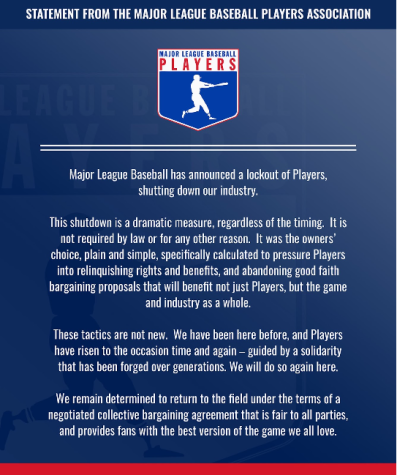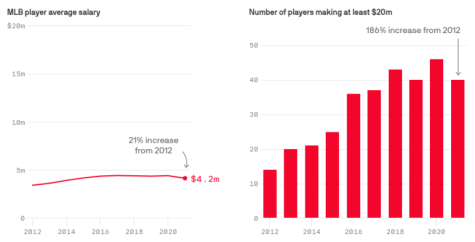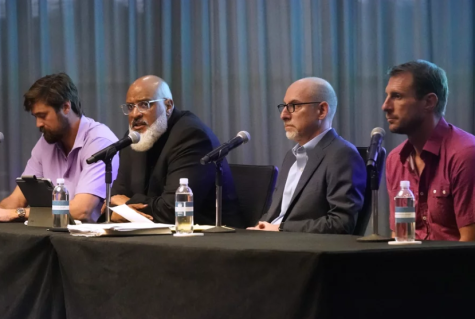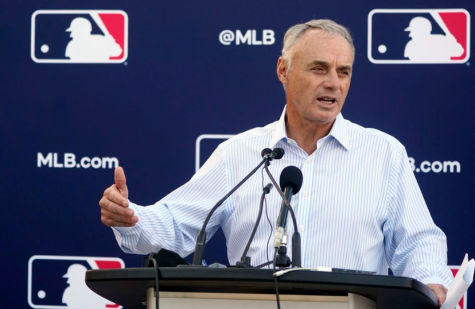A Guide to the Recent MLB Lockout
April 29, 2022
On December 2, 2021, the professional baseball world came to a halt. The MLB, Major League Baseball, went into a lockout, so free agency negotiations stopped, and league operations paused. The players and owners were in the middle of a huge feud, and MLB fans had to pay the price. There was a possibility that the 2022 season would be delayed or canceled totally.
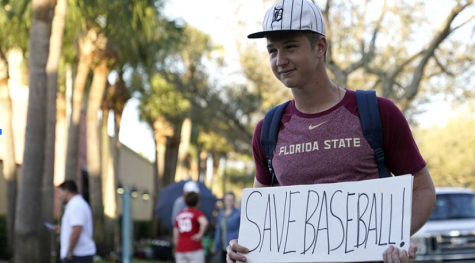 Pictured above: A baseball fan standing outside Roger Dean Stadium during the MLB lockout (picture from Seattle Sports 710 AM)
Pictured above: A baseball fan standing outside Roger Dean Stadium during the MLB lockout (picture from Seattle Sports 710 AM)
Is the season going to be canceled or delayed? Why? These are the questions that usually come up when a pro sports league has a lockout. A lockout is when the players union of a league and the owners or commissioner of a league do not agree on a new collective bargaining agreement in time, or if there is a dispute over a new agreement. A collective bargaining agreement (CBA) is an agreement between the union and employer that represents the employees. It usually discusses working hours, wages, and conditions. For sports, a CBA sets the rules for team revenue, player salaries, season structure, player safety, rules, and many other things in the specific league and sport. For the MLB, the CBA’s agreement lasts for five seasons, before it is set to expire. As the time approaches for it to expire, the players union and owners work together to make a new CBA to agree on and put in place for the next 5 years.
When there is no agreement in time for the CBA expiration, lockouts occur. This is not a new thing for pro sports, however. Each of the four major American sports leagues, the NBA, NFL, NHL, and MLB have had a few lockouts in their histories. These lockouts have a lot of effect on their leagues, as it sometimes leads to games being canceled. The best-case scenario is that the first few games are canceled and that’s it, as it’s rare but extremely possible for a lockout to cause an entire season to be canceled. The most infamous example of this was the 2004-05 NHL lockout, where the entire season and postseason were canceled due to no agreement between the NHL’s players union and owners. Before 2022, the MLB itself had eight work stoppages, three of which being lockouts and the others being strikes from the players union.
At 11:59 PM EST, on December 1, 2021, the most recent MLB CBA had expired, and the players’ union and owners were nowhere close to agreeing with each other. The following day, the MLB went into lockout. The MLB’s operations practically would cease, even official MLB social media pages and websites could not even use player likenesses. Why can’t the players union and owners agree? What are they wanting in possible changes for the league? How different can their needs really be?
Pictured above: The official statement from the MLBPA (MLB Players Association) on December 2, 2021, following the beginning of the lockout (picture from the MLBPA’s Twitter)
Let’s begin with the players. The main issue for them is that they are simply not getting paid enough. According to a report by the Associated Press, player salaries have declined 6.4% since the 2017 MLB season, which was the first season of the last CBA. The players blame this on a “luxury tax” threshold that needs to be increased. Most sports leagues have a salary cap that regulates how much teams can spend on players and it prevents richer teams from signing all big-name free agent players and keeps the competitive balance. The MLB, however, has a “Competitive Balance Tax”, which is basically a checks and balances system for the league. For teams that go over the threshold, penalties are required to be paid to the league. With a lower luxury tax, teams will purposefully avoid going over the threshold, which leads to player salaries being restrained. For the team and league owners, a lower luxury tax threshold means smaller team payroll and less player salary, and owners can maximize their profit. The biggest issue is that the MLB’s overall revenue is growing, while the amount teams can spend isn’t. According to Spotrac, from 2015 to 2019, MLB revenue went from $8.2 billion to $10.7 billion, while the average player salary dipped from $4.45 million to $4.17 million. The players believe that the luxury tax staying low while the MLB gains more money means lower salary, and numbers definitely back that.
Pictured above: Average MLB salary statistics over the years (graphs from axios.com)
The players also want free agency rules to be changed. The rule was that players must have played six years in the major leagues. These playing years are referred to as “years of service”, which officially refers to the amount of time a player has been on an MLB active roster or injured list. The main issue with this is that players typically would enter free agency at the end of their “primes”, a term used to mean the peak of their playing ability. Players would like free agency periods to begin sooner, so players can agree to terms of the money they’d want when they are at the peak of their career and contribution to the game. Players ask for an age limit instead, asking if a player can enter free agency at the age of 29 and a half years old.
There is also a huge issue with tanking that players want to be noted by the owners. Tanking is when teams intentionally build “bad” teams to lose games, in order to rebuild and get better draft picks. They ask for a new CBA to include incentives for winning games in order to give teams a reason to win. With this, the players want an expanded playoff and two more teams added to the field of ten teams that can participate in each playoff.
Pictured above:From left to right, Andrew Miller (free agent pitcher), Tony Clark (executive director of MLBPA), Bruce Meyer (chief union negotiator) and Max Scherzer (New York Mets pitcher). (Picture from NPR.org)
So… what about the owners? Owners mainly ask for two things: an expanded playoff and to keep the luxury tax threshold where it’s at. For the owners, an expanded playoff field means more playoff games. More games equal more TV revenue for the league, and that’s more money and more earnings for the league overall. They want to implement a fourteen-team playoff system, adding four teams to the ten-team playoff that was in place. Owners also want to limit the amount of money teams pay for players, without introducing a salary cap into the league. This need is the main reason players and owners could not agree for months, and it was the real issue of the lockout.
Despite all of these arguments, there are things that both sides want in a new CBA. For one, the owners and players can agree on the implementation of a universal designated hitter. A designated hitter is when, in the batting order, a player can hit in place for a pitcher. Only the American League side of the MLB had a designated hitter in place for their teams. The universal DH would mean both leagues in the MLB use this system, which would have a few positives. According to beyondtheboxscore.com, “Pitchers slashed .110/.150/.142 in 4,829 plate appearances during the 2021 season, with only 17 home runs.” For a good perspective of how low that is, a good batting average would be .270. Other reasons the universal DH helps is that there is another batting spot open for an extra hitter who doesn’t field, and there’s less of an injury risk for players better at-bat than on the field and also pitchers who don’t train their batting skills can be injured at the plate. Another thing the owners and players agree on is a restriction of service time manipulation. Service time manipulation is when teams take advantage of the rule that players enter free agency after six years in the majors, and so they intentionally keep their players in the minor leagues to extend the time they have the rights to the player. With this, teams can suppress the service time a player gets, which leads to less salary.
The lockout unfolded over the course of 99 days. The first meeting between the players union and owners, since the lockout began on December 2, was on January 13, 2022, over Zoom. The MLB offered a universal DH, 14-team playoff, performance bonuses, and increased pay for veteran players. The union, however, was unimpressed, and the meeting was over with no agreement. The two sides would continue meeting a few times over the next two months. One of these meetings lasted a brief 15 minutes, which was laughable to news sources following the lockout. On February 21, the MLB and players union decided to meet daily to meet a February 28 deadline. If no deal was met by February 28, regular-season games would begin to be canceled. After this deadline was not met, MLB commissioner Rob Manfred canceled the first two series of the 2022 season, which he announced at a press conference on March 1. This was a decision that was met with much backlash and frustration from baseball fans.
Pictured above: Rob Manfred, commissioner of the MLB, announcing the cancelation of the first two series of the 2022 season (picture from Boston Globe)
From March 6 to March 10, the two sides began meeting daily once again in order to reach a deal as soon as possible. The two sides’ negotiations began to trend in the right direction. Finally, on March 10, around 6 PM, the player union approved a newly proposed CBA by a vote of 26-12. The Owners followed this up with a unanimous vote of 30-0 to ratify the new CBA. The lockout officially ended an hour later, at 7 PM. The entire baseball world rejoiced as free agents began to negotiate contracts, spring training games went underway, and a new opening day date of April 7 was announced. With this, three extra days would be added to the end of the regular season to make up for the initial two series of games lost, in order for a normal 162-game season to be played. After 99 days of trial and frustration, professional baseball was finally back.
So, what terms were in the new CBA that made both sides finally agree with each other? New rules set in place regarded the official implementation of the previously discussed universal designated hitter, a playoff expansion to 12 teams, and the minimum MLB salary to $700,000, an increase of around $130,000 from the previous minimum. The league and union also decided to increase the luxury tax by $20 million, with the lowest threshold now being set at $230 million. Regarding salaries, the new CBA also adds a rule where if a player finishes top 2 in the Rookie of the Year award voting, they will receive a full year of service time, no matter when they were called up to the majors. For retired players, pension benefits have increased, as well as medical benefits for current players. Other big changes include a 14-second pitch clock to be put in place in the 2023 season, which will definitely speed up games and make them quicker-paced, as well as an official ban on defensive shifts. USA Today describes a defensive shift as “when a team strategically places position players in spots on the field where a batter is most likely to hit the ball.” The shift is a move disliked by owners, because, as ForThe Win sportswriter Andrew Joseph explains, “There are few plays more frustrating for a baseball fan watching on TV than when a hard-hit ball up the middle — seemingly a base hit — ends up being a routine ground out because the defense had the third baseman camped behind second base.” From 2023 onwards, teams will be required to have two infielders on each side of second base.
With two sides finally coming together to agree, along with changes that baseball fans enjoy seeing, the 2022 MLB season is projecting in the right direction. The season began with a matchup between the Milwaukee Brewers and Chicago Cubs, on April 7. Baseball is finally back and all sports fans can sigh a breath of relief!

